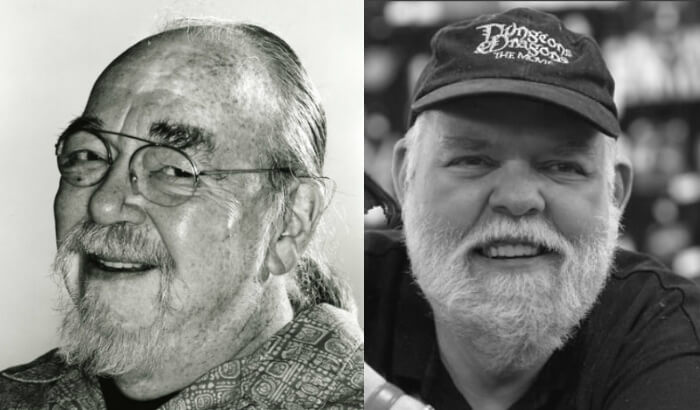
Dungeons & Dragons (D&D) is one of the most influential and iconic tabletop role-playing games ever created. First published in 1974, D&D has captivated gamers for nearly 50 years with its fantasy-based adventures, intricate world-building, and emphasis on collaborative storytelling. But who exactly brought this groundbreaking game to life? The origins of D&D can be traced back primarily to two innovative game designers, Gary Gygax and Dave Arneson, who leveraged their passion for tabletop war gaming and open-world exploration to develop a new kind of immersive roleplaying experience.
Gary Gygax is widely considered the father of Dungeons & Dragons. As a teenager in Lake Geneva, Wisconsin during the late 1950s and early 1960s, Gygax became enthralled with tabletop war gaming. He co-founded the Castle & Crusade Society as a forum for over two dozen local gamers to play historical simulations and his own medieval themed variant, Chainmail. Building on this initial success, Gygax designed Dungeons & Dragons as a more open-ended fantasy game, allowing players to roleplay unique heroic characters, such as fighters, magic-users, and clerics, on adventures full of drama and imagination.
Gygax was inspired by pulp fantasy and sci-fi novels, particularly the works of authors like Robert E. Howard, Edgar Rice Burroughs, and Jack Vance. He drew upon common fantasy tropes like haunted dungeons, deadly traps, mystical spells, mythical beasts, and treasures hoarded by sinister dragons. Gygax collaborated with his friend and fellow game enthusiast Dave Arneson to test and refine early versions of D&D through play-by-mail games and miniatures sessions.
Dave Arneson, an equally innovative game designer from Minnesota, is credited as the co-creator of D&D. As a student at the University of Minnesota in the late 1960s, Arneson joined Gygax’s Castle & Crusade Society and became immersed in the creative possibilities of tabletop games. When Gygax later sent him a draft of Chainmail’s “Fantasy Supplement” in 1970, Arneson began to adapt the rules into a more roleplaying focused format, where players would cooperatively control single hero characters in a fully realized fantasy realm.
Arneson developed his own fantasy game scenario he called Blackmoor, often viewed as the precursor to Dungeons & Dragons. Blackmoor pioneered core D&D concepts like experience points, character levels, dungeon crawls, and the alignment system. Arneson play tested Blackmoor for several years in the early 1970s before collaborating more closely with Gygax to build D&D. While Gygax provided much of the game’s foundational mechanics and overall tone, Arneson’s contributions brought the roleplaying element that made D&D truly immersive.

The seeds of D&D were also planted at the Gen Con gaming convention, which Gygax founded in 1968 as a gathering for tabletop war gamers and science fiction fans. In 1972, Gygax met fellow game designers, Rob Kuntz and Terry Kuntz, who shared his passion for creating fantasy adventures. They were soon playtesting early variations of D&D and provided key input as the game developed. Guidance from Gen Con attendees and feedback from Arneson’s Blackmoor players helped shape D&D in its formative years.
By 1973, Gygax and Arneson were corresponding extensively on their ideas for D&D, which they envisioned as a commercially viable tabletop RPG or “fantasy campaign” appealing to war gamers and fantasy fans. After collaborating long distance, they eventually met in Lake Geneva in 1973 to formalize their creative vision. By the end of the year, plans were made to publish 1,000 boxed sets of the complete Dungeons & Dragons rules.
D&D was first brought to market in 1974 by Gygax’s publishing company, Tactical Studies Rules (TSR). The earliest box set included three slim, staple-bound rulebooks outlining D&D’s core mechanics: Men & Magic, Monsters & Treasure, and The Underworld & Wilderness Adventures. Despite modest production values and amateurish artwork, this inaugural release of D&D was enthusiastically received by gamers looking for a new kind of immersive fantasy experience.

While Gygax and Arneson are clearly D&D’s principal co-creators, many others contributed to refining the game in those early years. D&D benefited greatly from playtesting and input from the robust tabletop gaming communities in Lake Geneva and the Twin Cities where Gygax and Arneson lived. Key playtesters offering feedback and ideas included Rob Kuntz, Terry Kuntz, Ernest Gygax (Gary’s son), Don Kaye, and David Megarry. Leading wargame publisher Avalon Hill also provided early guidance on preparing D&D for commercial release before TSR took over publishing.

In many ways, Dungeons & Dragons was a communal creative work, a fusion of the diverse tabletop gaming experiences and passions shared by Gygax, Arneson, and their fellow gamers in the early 1970s. However, without the brilliance and drive of Gary Gygax and Dave Arneson in forging a new kind of open-ended, collaborative fantasy roleplaying, D&D as we know it today likely wouldn’t exist. Their innovative game design talents brought this collective creativity to life and launched a tabletop RPG phenomenon that continues to inspire gamers around the world nearly 50 years later.
If you purchase any products linked on our website, we may receive an affiliate commission.


